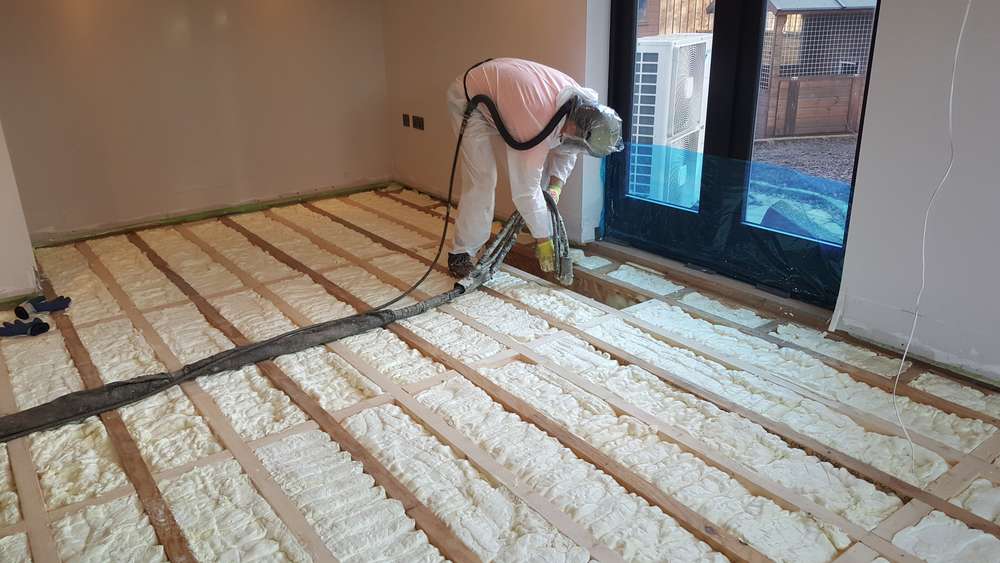Attic Spray Foam Insulation Ashbourne
3 Bed Semi Attic Insulation Ashbourne

Attic Insulation Ashbourne
Spray foam can be useful in many conditions. Spray foam is beneficial for roofs, windows or exterior walls.
Spray foam insulation will keep your home warm during winter and cool in summer. Spray foam insulation allows the house to breathe because it allows moisture-laden atmosphere to escape through its “Cell” structure.
Benefits of Spray Foam Insulation for your home
Other applications include farm houses, industrial and commercial buildings, sheds as well shipping containers and vessels.
It creates an airtight barrier around your home, keeping out rain and cold winds. It allows the heat from your home to escape, which is what most other insulating products today fail to do.


Cost Price Of Spray Foam Insulation
Spray foam insulation has proven to be the most effective insulation material on the market today. It is more efficient than traditional insulating materials like fiberglass, rock wool and cellulose.
Spray foam insulation is excellent as a sound barrier. It reduces outside noise by up to 50%. It is a great advantage if a company or home is in a densely populated area or close to an airport.
Insulate Your Ashbourne Property Properly
It’s commonly used to block sound from traveling between rooms or floors. It is especially useful for bathroom walls where noises from toilets and showers can cause nuisances.
It’s simple to use, and it doesn’t disrupt your everyday activities.
Traditional Irish homes can be insulate in just one day.
It reduces the noise of in-wall and under-floor pipes by encasing them and isolating them.

You will need to cover the joists with boards if you intend to store items in the attic or loft. The insulation will not be thick enough if it is only between the joists.
This material reduces the sound transference significantly when it is used within walls, attics or roofs, as well as floors, in comparison with fibreglass, rock wool, and polystyrene board. Because of its dense composition and application process, it creates an airtight envelope. It blocks sound from outside, including traffic, pedestrianised streets, and areas near airports.
It prevents sound from being generated within a structure from reaching floors above, below, or into adjacent spaces. Spray foam insulation will dramatically reduce the sound levels of many noises within a structure, including talking, hair dryers (phones), office computers and printers as well as running showers, laundry machines, clothes dryers.
Spray foam insulation is flexible but densely packed with millions if minute air bubbles. This will absorb vibrations from the floor as well as the sound waves. Spray foam insulation reduces the transmission and propagation of airborne noises by sealing every crack and crevice.
Spray foam insulation reduces, if any, the sound of water passing through pipes. The insulation completely surrounds pipes to prevent them from moving and keeps them secure. It eliminates the sound that is made when hot water flows through pipes from heating system. This causes wooded joints to expand, creak, and groan.
It also prevents heat from escaping the upper floors. This causes the lower floors of the building to cool down, which then requires more heat in order to keep them warm.
It is possible to insulate lofts if they are accessible and have no damp or condensation issues.
In an uninsulated house, 25% of heat escapes through the roof. Insulating your loft or attic is a great way to cut heat loss and save money on heating.
You can use mineral wool insulation rolls if you have easy access and your loft joists remain regular. The insulation begins by placing the first layer between the joists. These are the horizontal beams that form the loft’s floor. A second layer is then laid at right angles to cover and seal the joists.
In order to have enough insulation, raise the floor so that enough mineral wool can be fitted below the new floor. You can install timber battens on the floor joists. Or, you can use purpose-built legs made of plastic that fit on the leg and support the floor. It is essential to allow ventilation between insulation and boards in order to prevent condensation.
Do not squash the mineral Wool when fitting the boards onto the top. This will cause it to lose its insulation properties.
Insulation stops heat loss from living spaces. By making your loft space cool, you can prevent damp or condensation from developing. Consider increasing ventilation if you’re installing loft insulation by yourself.
Another way to insulate your loft would be to place insulation between and above the rafters. These are sloping timbers which make up the roof. You have two options: rigid insulation boards that are carefully cut to your specifications or foam insulation spray between the rafters.
Some companies offer to fix a roof that is leaking or damaged by applying foam insulation directly to the roof. This will not solve the problem. This is not something that we recommend. You must ensure that your roof is in good condition before you apply insulation.
If you plan to use your loft for heating, you’ll need to make a room in the roof.
You must insulate your loft if you plan to use it as a living area or if you have one.
To keep your home fresh, dry, and healthy, air must flow in and out. Good installers will ensure that there is no obstruction or sealing of any inadvertent ventilation. You should not cover vents, grilles, or airbricks when you are doing DIY insulation.
You can have blown insulation installed if your loft is difficult to access. A professional will use specialist equipment and blow the right insulation material into every space. They can use mineral wool fibres or treated cellulose or polyurethane.
Flat roof insulation is a great way to save money on heating, as well as loft insulation. The extent of the flat roof on your property will impact how much savings you receive.
You can probably insulate your loft yourself if it is accessible and does not have damp problems. If there are damp issues or more complex insulation needs, a professional should be hired.
Cooler air could cause cold draughts to enter your loft hatch due to insulation. You can prevent this by fitting an insulated loft hatch, and placing strips of draught-exclusion material around hatch edges.
Insulating your ground floor can help you keep your home warm and reduce your carbon footprint.
Insulating a loft is an effective way to lower heating bills, be more efficient and warm your home in the winter. It doesn’t matter if you have insulation in place, but it is important to get the right amount to make it work.
Loft floor rolls – These are the classic option. They are laid along the loft’s floor. They are much easier to lay than insulated floors boards. They come in both loose and encapsulated (blankets) rolls. These can be used to create base and top layers. You can use stilts or boards to board them. This will create a raised platform that is suitable for storage.
These suggestions and recommended items aren’t included in this article’s list of materials or tools. It is important to make sure that you have all the information you need before you start insulation your loft floor.
There may be some insulation in your home, but it may not work well. It could be that the insulation has been compressed with storage boards or not being topped up for a while. Older properties may have a loft floor as low as 25mm deep.
There is no need to remove loft floor insulation. To achieve the recommended amount, you can just add one or several layers to it. The article will provide more details about how much you should be consuming.
Your loft floor’s joint spacings will affect the width of the roll. This is because the insulation rolls between these joists. We recommend you select one that’s close to the spacing of your joists. This minimizes the need to trim.
The insulation’s required thermal resistance. If you only want to lay loft rolls, there is an alternative method that measures the insulation thickness. For more information, see the section ‘How do I calculate the thickness of loft floor insulation?
Areas We Service


Parkhill, Dublin
01 5255297

